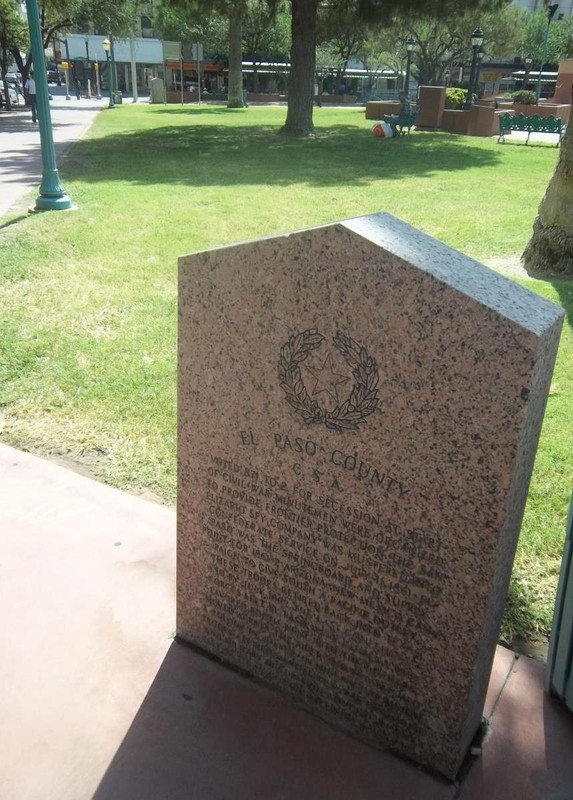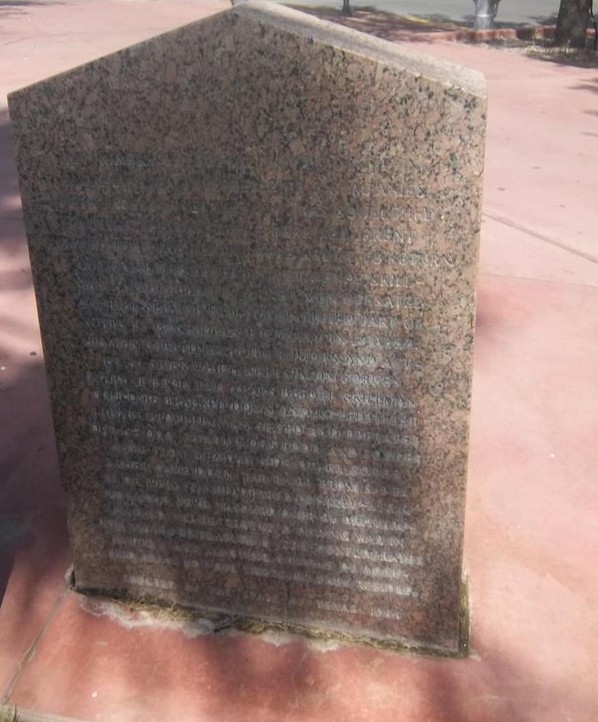El Paso County Civil War Historical Marker
Introduction
Text-to-speech Audio
This marker is inscribed with information about El Paso County during and slightly before the Civil War. What follows is directly from the marker and it's inscription. El Paso voted 871 to 2 in favor of secession. At the start of Civil War local Minutemen were organized to provide frontier protection. The San Elizario Spy Company was mustered into Confederate service on July 11, 1861.
Images
Picture of El Paso Memorial Marker (Front) Picture taken by Zacharias Beau T, September 11, 1930

Picture of El Paso Memorial Marker (Back) Picture taken by Zacharias Beau T, September 11, 1930

Backstory and Context
Text-to-speech Audio
El Paso voted 871 to 2 in favor of secession. At the start of Civil War local Minutemen were organized to provide frontier protection. The San Elizario Spy Company was mustered into Confederate service on July 11, 1861.
El Paso was the springboard and supply point for 1861-2 Arizona - New Mexico campaign to give South a Pacific outlet. These troops retired back into Texas and by July 1862, the last Confederate forces left El Paso. Many citizens who favored South went with them, others moved across the river and established a colony in Juarez. In mid-August, Union troops arrived. Martial law was declared and military occupation - longest in any part of Texas - continued until war's end.
The number of federal troops occupying El Paso never exceeded 2 or 3 companies. Open pro-southern feeling was squelched during the war. There were recurrent rumors that the Texans were about to return and drive the federals out. Henry Skillman and his band of armed men operated courier service from unoccupied part of state to Confederate colony in Juarez. His men spread invasion rumors and acted as spies, which kept Union forces wary. It took two years before Skillman could be tracked down and killed. Most private property was seized and operated during occupation. Most food and fodder came from Mexican side. Other goods either came down the river from Santa Fe or were manufactured locally. Local elections were watched over by military. El Paso was represented during war in the Texas Legislature by pro-Confederates under a law allowing citizens of occupied areas to vote wherever they resided. This marker was erected by the State of Texas, 1963
El Paso was the springboard and supply point for 1861-2 Arizona - New Mexico campaign to give South a Pacific outlet. These troops retired back into Texas and by July 1862, the last Confederate forces left El Paso. Many citizens who favored South went with them, others moved across the river and established a colony in Juarez. In mid-August, Union troops arrived. Martial law was declared and military occupation - longest in any part of Texas - continued until war's end.
The number of federal troops occupying El Paso never exceeded 2 or 3 companies. Open pro-southern feeling was squelched during the war. There were recurrent rumors that the Texans were about to return and drive the federals out. Henry Skillman and his band of armed men operated courier service from unoccupied part of state to Confederate colony in Juarez. His men spread invasion rumors and acted as spies, which kept Union forces wary. It took two years before Skillman could be tracked down and killed. Most private property was seized and operated during occupation. Most food and fodder came from Mexican side. Other goods either came down the river from Santa Fe or were manufactured locally. Local elections were watched over by military. El Paso was represented during war in the Texas Legislature by pro-Confederates under a law allowing citizens of occupied areas to vote wherever they resided. This marker was erected by the State of Texas, 1963
Sources
T., Zacharias Beau. "El Paso County Historical Marker." El Paso County Historical Marker. October 22, 2011. Accessed August 11, 2016. http://www.hmdb.org/marker.asp?marker=48627.
